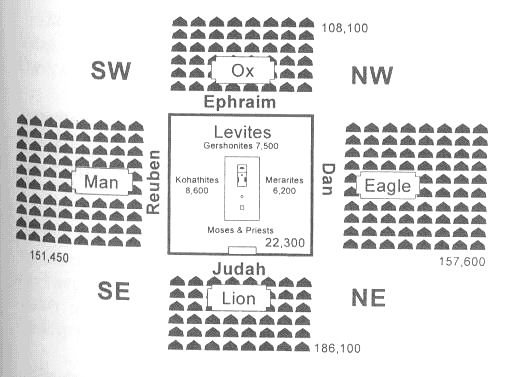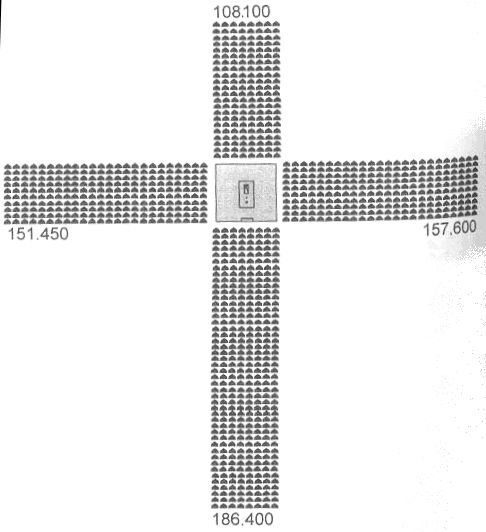When the tribes of Israel was encamped in the desert they should follow an order, a positioning of the tribes in the huge nomadic camp. This order, this arrangement, the organization showed us a design that could only be seen in its entirety from the top of a mountain for example. The figure formed reveals something extraordinary.
The Census
The count of the tribes is detailed in Numbers chapter 1. The true population represented was obviously higher than this count as only men over 20 years old and able to go to war, were counted. Most scholars estimated that women, children and the elderly would increase the number of people times three. The whole camp would be approximately 2 million people.
Although the numbers of each tribe, apparently, not reveal us much, the total of each of the four groups will be quite revealing:
Quando as tribos de Israel se acampavam no deserto deveriam seguir uma ordem, um posicionamento das tribos dentro do gigantesco acampamento nômade. Essa ordem, esse arranjo, essa organização mostrava um desenho que só poderia ser visto em sua totalidade do alto de uma montanha por exemplo. A figura formada nos revela algo extraordinário.
O Censo
A contagem das tribos é detalhada em Números, capítulo 1. A verdadeira população representada era obviamente maior que esta contagem, pois apenas homens, acima de 20 anos e aptos a irem para guerra, foram contados. A maior parte dos estudiosos estima que mulheres, crianças e idosos multiplicariam o número por três ou mais. O arraial todo iria ter aproximadamente 2 milhões de pessoas.
Ainda que os números de cada tribo aparentemente não revelem muito, os totais de cada um dos quatro grupos serão bastante reveladores:
| Judá/Judah | 74.600 | Rúbens | 46.500 | |
| Issacar/Issachar | 54.400 | Simeão/Simeon | 59.300 | |
| Zebulom/Zebulun | 57.400 | Gade/Gad | 45.650 | |
| 186.400 | 151.450 | |||
| Efraim/Ephraim | 40.500 | Dã/Dan | 62.700 | |
| Manassés/Manasseh | 32.200 | Aser/Asher | 41.500 | |
| Benjamim | 35.400 | Naftali/Naphtali | 53.400 | |
| 108.100 | 157.600 |
Cardinal Points
Each of the camps, of three tribes each, should camp in one of four directions (North, South, East, West), respecting the camp of the Levites who would be around the tabernacle. We can not know precisely the space that was needed for the Levites, about 30 meters on each side, or 100 meters. But whatever the space, we will adopt this space as a basic unit.
To fully understand all the implications, you need to try to think like a rabbi: you have to keep an extremely high respect to the precise details of the instructions. They measured accurately in their zeal to fulfill every letter of the law.
The tribes of Judah, Issachar, and Zebulun - collectively called the Camp of Judah - had to camp to the east of the Levites. Then there is a technical problem. Note that if the camp width of them was greater than the width of the camp of the Levites, the surplus would be in the southeast or northwest, and not to the east. So if were strictly followed his instructions, his camp would have to have just the same width of the Levites, and then they would have to extend to the east to get the necessary space.
The camp of Reuben, Ephraim and Dan had the same situation south, west and north respectively. The length of each is proportional to the total population of each camp.
Pontos Cardeais
Cada um dos arraiais, de três tribos cada, deveria acampar num dos quatro pontos cardeais (Norte, Sul, Leste, Oeste), respeitando o arraial dos levitas que ficaria junto ao tabernáculo. Não podemos saber com precisão o espaço que era necessário para os levitas, se era 30 metros de cada lado, ou 100 metros. Mas seja lá qual for o espaço, adotaremos este espaço como uma unidade básica.
Para entender completamente todas as implicações, você precisará tentar pensar como um rabi: você tem que manter um respeito extremamente elevado aos detalhes precisos das instruções. Eles adotavam medidas heróicas no seu zelo por cumprir cada letra da lei.
As tribos de Judá, Issacar e Zebulom – coletivamente chamadas de Arraial de Judá – tinham que acampar ao leste dos levitas. Então surge um problema técnico. Perceba que, se a largura do arraial deles fosse maior que a largura do arraial dos levitas, o excedente estaria no sudeste ou noroeste, e não ao leste. Portanto, se eles fossem seguir estritamente suas instruções, seu arraial teria que ter apenas a mesma largura dos levitas, e então eles teriam que estender-se ao leste para obter o espaço necessário.
Os arraiais de Rúbens, Efraim e Dã tinham a mesma situação ao sul, oeste e norte respectivamente. A extensão de cada um seria proporcional à população total de cada arraial.
Ephraim – Efraim |  |
The Aerial View
If we add what we can infer from the biblical account, you can imagine how the camp of Israel was seen from above: the Tabernacle and the Levites in the center, surrounded by the four faces of the flags of the tribes, and each of the four camps of Judah, Ephraim , Reuben and Dan, extending the four cardinal directions.
We can also note the approximate size of each tribe, to determine the relative size of each camp when they were extended in each of the four cardinal directions. Here are the impressive results:

When the Israelites camped, they formed a giant cross!
Hidden in the Torah, and not in the New Testament!
The New Testament actually is hidden in the Old Testament; The Old Testament is revealed in the New Testament.
In the heart of the camp the tabernacle, where the Israelites performed their worship of God. Where happening daily sacrifice of a lamb ... ...
And immediately we remember that guy dressed in camel clothes who lived in the desert that when saw Jesus pass by him screams:
- Behold the Lamb of God! Who takes away the sin of the world
Quando os israelitas acampavam, eles formavam uma gigantesca cruz!
Oculto na Torá, e não no Novo Testamento!
O Novo Testamento, na verdade, está oculto no Velho Testamento; O Velho Testamento é revelado no Novo Testamento.
No coração do acampamento o tabernáculo, onde os israelitas realizavam seu culto a Deus. Onde acontecia diariamente a imolação...de um cordeiro...
E imediatamente relembramos daquele sujeito vestido com vestes de camelo que morava no deserto que quando vê Jesus passar grita:
- Eis o Cordeiro de DEUS! Que tira o pecado do mundo...


Nenhum comentário:
Postar um comentário